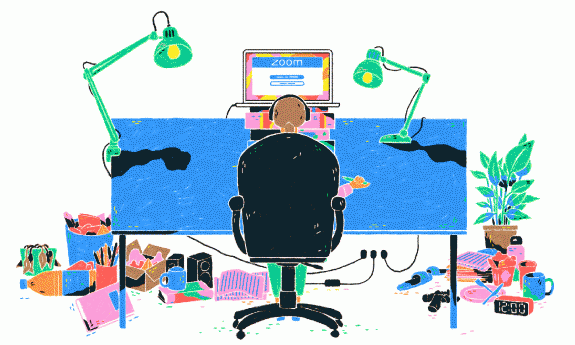
How to ace your next online job interview
COVID-19 has had a huge impact on the way we work — and that includes how we interview for that work.
While remote job interviews are nothing new, they’re now the norm as companies grapple with reopening. As we prepare for them, there are a few important things that we should bear in mind, according to career coach Dr. Dawn Graham.
Of course, the standard things that you’d do to prepare yourself for any interview haven’t changed — you should still research the organization and your prospective role there, use LinkedIn to see what the people who used to work in that position are doing now, and prepare questions for your interviewer or interviewers.
“But something that’s new with video is you, the candidate, are now responsible for setting up the environment,” points out Graham, a Philadelphia-based author and career expert. “You’re used to going into an office where the environment is already prepared, and you don’t have a lot of control. One of the things we have to recognize as job seekers is the environment setup is now half up to us, and we really have to take that seriously.”
Part of that means being in control — well, as much as you can — of your technology. “It’s always important to control what you can before an interview, as there’s so much we can’t control,” says Graham. “Everybody is getting much more comfortable using video technology, so the expectations are higher that you know how to use it. And if you’re going to be working in a job where you’ll be doing a lot of interacting on video, they’re assessing that so how you approach this is part of your interview.”
Here’s Graham’s advice on how to shine in your next online interview:
Find the best environment in your home
While closets may seem like a safe choice for an interview — they tend to be small and have a door you can close — they can also be echoey and dark. Graham says you should identify a space in your home with the best combination of sound and lighting quality possible, so if there’s a room with natural light where you can close the door, go there instead.
In terms of the sound and lighting, “you don’t need to go out and buy expensive equipment or a new sound system,” says Graham. Instead, do a practice run — multiple runs are ideal — on your existing set-up with a friend at the same time of day as your interview, so you can see how the light and neighborhood noise is at that time.
Try to ensure that your background is as neutral as possible. If your real-life background is busy or cluttered, it’s OK to use a plain Zoom background, says Graham. Just use one that you’ve tried in advance so it doesn’t create any strange glitches when you move around. “I’ve also seen people — and this is easy — put a sheet up behind themselves,” she adds.
It’s OK to ask for your interview to happen at a time you’re less likely to be disturbed
If you know your neighborhood is louder at certain times or you and your partner are trying to balance your work schedules so that one of you can keep children and/or pets out of the room, you can request a specific time. Graham explains, “You wouldn’t normally say to an employer ‘Here’s when I’d like to interview’, but I think they would be appreciative of the fact you’re trying to put your best self forward.”
Put your technology to the test
As mentioned above, do at least one full test call with a friend beforehand — ideally, at least a few days before your interview — to make sure everything works. Ensure that your computer has all the latest updates installed and that your Zoom (or whatever platform you’ll be interviewing on) is up to date.
If there are other people using the Wi-Fi in your home, you may want to ask them to stay offline during your interview. If your signal is sometimes iffy, you might also consider purchasing a Wi-Fi booster to ensure your connection is stable. Log on an hour before your test (and your interview) to make sure you don’t need to install any last-minute updates. During your interview, keep an eye on the details, like ensuring your screen name is displaying your first and last names and that they’re spelled correctly.
Although it might feel awkward, it’s important for you to practice out loud, record yourself during your test run — and then watch it. This isn’t just to get comfortable with the technology and ensure that you can be seen and heard with ease, but also to prepare when things to go wrong. Because they will.
“Be ready for glitches,” says Graham. No matter how much you practice, technology will still be technology and there’s always the possibility that some kind of issue will arise during your call. “If there’s an interruption, that can really throw you off when you’re already nervous about an interview,” she explains. “It’s important to do some test runs and let glitches happen so you learn how to handle them gracefully and move on and move forward.”
And your clothing too
If you’re not used to being on camera, you should evaluate your interview attire through the lens of whether it works on video or not. “Record yourself in what you’re going to wear,” says Graham. “If you have very sparkly jewelry or have horizontal lines or a very complex pattern, that can be very distracting.” In particular, tightly striped patterns can create a strobing effect. Another factor to consider: What you’re wearing should contrast with your background (so you don’t look like a floating head), and you also don’t want it to interact strangely with your Zoom background if you’re using one.
Your body language is still important — even more so
With less of you to focus on — and less of an environment to be distracted by — your body language actually becomes even more important on Zoom, according to Graham. This is why recording yourself in advance and watching it afterwards are so important.
“I know it’s painful; I do,” says Graham. “But I think we often don’t recognize the gestures that we have — for example, playing with our hair or drinking a lot of water. When you’re in a conference room, those things might not be noticeable, but when you’re on a Zoom screen and you’re literally in this little box, a lot of those natural body movements tend to be very exaggerated.” It’s not that you can’t drink water during an interview, but you can seem nervous if you’re constantly sipping away. It’s also not the time for you to bring out your “What happens in Vegas stays in Vegas” mug.
Most of us are not completely accustomed to being on camera, so use your practice time to get more comfortable so your personality still shines through. That can be as simple as redirecting where you’re looking.
One of the oddest things about being on Zoom is that you’ll need to coach yourself to make eye contact with the camera, not the person — because when you look at the other person, you’re not actually looking them in the eye. Graham says, “That’s one of the reasons that Zoom always feels a little bit off, because you’re mismatching but you want to have that eye contact.” With that in mind, you may need to adjust your computer with a few books to get it to the appropriate level.
During the interview, turn off notifications and close windows and tabs
Getting a sudden Skype or Slack call or even an email can really throw you off, says Graham. “It’s not only distracting to the people on the call, but it’s certainly distracting to you to see that you just got a message. I think it’s really important to close down everything else on your computer — except what you need to have open.” By closing windows, you’re also giving your computer and internet connection the best chance to make it through the call without glitches.
Companies are asking new questions, and you can too
Graham has noticed that companies are asking candidates “How have you handled the COVID situation?” or “What have you been doing with your time?” These aren’t questions that you’d normally be prepared for, so it’s important to reflect on them in advance. As with any other interview question, Graham recommends thinking about your audience and how you can apply your answer to what they need or what they’re looking for.
You should also feel free to ask this question in return, says Graham. Since you probably won’t have the opportunity to see their office and get a sense of their work culture during your interview, it’s reasonable for you to ask how they’ve responded to the pandemic or raise other questions about their culture. Graham suggests asking questions like “Who are your heroes?” or “Who is rewarded at your organization?” She says, “Those types of things really get to the heart of the culture. So I think you need to do a little bit more work as a candidate to dig into that now.”
We miss a lot by not being able to see our potential workplace, and employers haven’t necessarily come up with a good solution for that, says Graham. “We’re all sort of evolving right now, and I think that puts a lot more onus on job seekers to get the information they need to make a good decision.” If you advance in the interview process, you should ask to meet some of your potential colleagues on Zoom to get more of a feel for the company. In addition, don’t be afraid to network and reach out to other people who’ve worked there to learn more about their experience.
Ultimately, you shouldn’t feel any more nervous about a Zoom interview than you would about a normal one. Video interviews can give you a lot more control over the space that you’re in. Plus, you won’t need to worry about navigating a new building or neighborhood or arriving there exactly the right amount of early. And just remember, says Graham: The employer has already selected you from their applicant pile, and they want to meet you. So bring your best self.
Watch Dawn Graham’s TEDxJHUDC talk here:
ABOUT THE AUTHOR
Mary Halton is Assistant Ideas Editor at TED, and a science journalist based in the Pacific Northwest.
This post was originally published on TED Ideas. It’s part of the “How to Be a Better Human” series, each of which contains a piece of helpful advice from someone in the TED community; browse through all the posts here.




